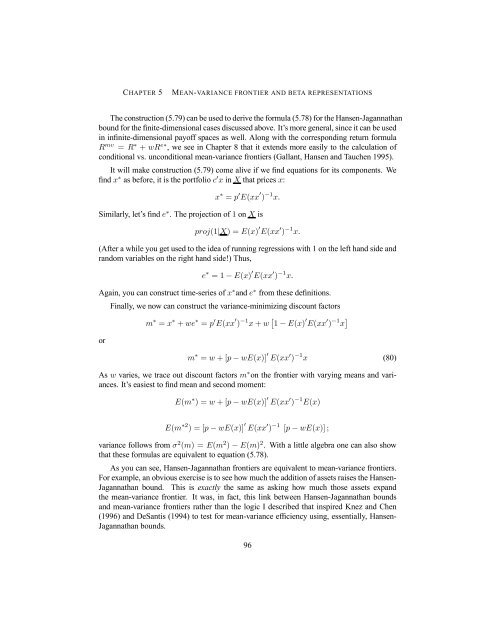Asset Pricing John H. Cochrane June 12, 2000
Asset Pricing John H. Cochrane June 12, 2000
Asset Pricing John H. Cochrane June 12, 2000
Create successful ePaper yourself
Turn your PDF publications into a flip-book with our unique Google optimized e-Paper software.
CHAPTER 5 MEAN-VARIANCE FRONTIER AND BETA REPRESENTATIONS<br />
The construction (5.79) can be used to derive the formula (5.78) for the Hansen-Jagannathan<br />
bound for the finite-dimensional cases discussed above. It’s more general, since it can be used<br />
in infinite-dimensional payoff spaces as well. Along with the corresponding return formula<br />
Rmv = R∗ + wRe∗ , we see in Chapter 8 that it extends more easily to the calculation of<br />
conditional vs. unconditional mean-variance frontiers (Gallant, Hansen and Tauchen 1995).<br />
It will make construction (5.79) come alive if we find equations for its components. We<br />
find x∗ as before, it is the portfolio c0x in X that prices x:<br />
x ∗ = p 0 E(xx 0 ) −1 x.<br />
Similarly, let’s find e ∗ . The projection of 1 on X is<br />
proj(1|X) =E(x) 0 E(xx 0 ) −1 x.<br />
(After a while you get used to the idea of running regressions with 1 on the left hand side and<br />
random variables on the right hand side!) Thus,<br />
e ∗ =1− E(x) 0 E(xx 0 ) −1 x.<br />
Again, you can construct time-series of x∗and e∗ from these definitions.<br />
Finally, we now can construct the variance-minimizing discount factors<br />
m ∗ = x ∗ + we ∗ = p 0 E(xx 0 ) −1 x + w £ 1 − E(x) 0 E(xx 0 ) −1 x ¤<br />
or<br />
m ∗ = w +[p − wE(x)] 0 E(xx 0 ) −1 x (80)<br />
As w varies, we trace out discount factors m ∗ on the frontier with varying means and variances.<br />
It’s easiest to find mean and second moment:<br />
E(m ∗ )=w +[p − wE(x)] 0 E(xx 0 ) −1 E(x)<br />
E(m ∗2 )=[p − wE(x)] 0 E(xx 0 ) −1 [p − wE(x)] ;<br />
variance follows from σ2 (m) =E(m2 ) − E(m) 2 . With a little algebra one can also show<br />
that these formulas are equivalent to equation (5.78).<br />
As you can see, Hansen-Jagannathan frontiers are equivalent to mean-variance frontiers.<br />
For example, an obvious exercise is to see how much the addition of assets raises the Hansen-<br />
Jagannathan bound. This is exactly the same as asking how much those assets expand<br />
the mean-variance frontier. It was, in fact, this link between Hansen-Jagannathan bounds<br />
and mean-variance frontiers rather than the logic I described that inspired Knez and Chen<br />
(1996) and DeSantis (1994) to test for mean-variance efficiency using, essentially, Hansen-<br />
Jagannathan bounds.<br />
96
















